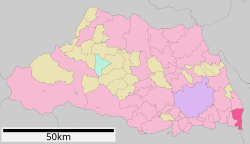Misato, Saitama (city)
|
Misato 三郷市 |
|||
|---|---|---|---|
| City | |||

Misato City Hall
|
|||
|
|||
 Location of Misato in Saitama Prefecture |
|||
| Location of Misato in Saitama Prefecture | |||
| Coordinates: 35°49′48.5″N 139°52′20.4″E / 35.830139°N 139.872333°ECoordinates: 35°49′48.5″N 139°52′20.4″E / 35.830139°N 139.872333°E | |||
| Country | Japan | ||
| Region | Kantō | ||
| Prefecture | Saitama Prefecture | ||
| Area | |||
| • Total | 30.13 km2 (11.63 sq mi) | ||
| Population (February 2016) | |||
| • Total | 136,933 | ||
| • Density | 4,540/km2 (11,800/sq mi) | ||
| Time zone | Japan Standard Time (UTC+9) | ||
| - Tree | Castanopsis | ||
| - Flower | Rhododendron | ||
| - Bird | Tachybaptus ruficollis | ||
| Phone number | 048-953-1111 | ||
| Address | 648-1 Hanawada, Misato-shi, Saitama-ken 341-8501 | ||
| Website | Official website | ||
Misato (三郷市 Misato-shi?) is a city located in Saitama Prefecture, in the central Kantō region of Japan. As of 1 February 2016[update], the city had an estimated population of 136,933 and a population density of 4540 persons per km². Its total area was 30.13 square kilometres (11.63 sq mi).
Misato is located in the extreme southeastern corner Saitama Prefecture in the middle of the Kanto plain, with the Edogawa River and the Naka River forming two of its borders. It is approximately 20 kilometers from downtown Tokyo.
The area of modern Misato was originally part of Shimōsa Province, and was transferred to Musashi Province in 1683. The villages of Hikonari, Waseda, Togasaki and Yagisato were created within Kitakatsushika District, Saitama with the establishment of the municipalities system on April 1, 1889. Togasaki and Yagisato merged on July 1 1933 to form the village of Towa. On September 30, 1956, Hikonari, Waseda and Towa merged to form the village of Misato, which was raised to town status on October 1, 1964. The area experienced rapid population growth in the 1960s and 1970s with the large-scale construction of public housing.
Misato was elevated to city status on May 3, 1972.
Due to this location, Misato is primarily a bedroom community with a significant percentage of its population commuting to the Tokyo metropolis for work.
...
Wikipedia



